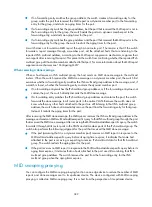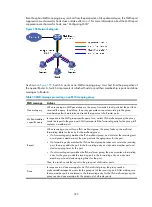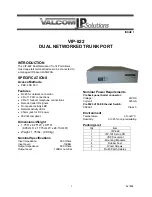
395
Configuring a port as a simulated member host
Generally, a host that runs MLD can respond to MLD queries. If a host fails to respond, the multicast router
might deem that the IPv6 multicast group has no members on the subnet, and removes the corresponding
forwarding path.
To avoid this situation, you can configure a port on the switch as a simulated member host for an IPv6
multicast group. When the simulated member host receives an MLD query, it replies with an MLD report.
Therefore, the switch can continue receiving IPv6 multicast data.
A simulated host is equivalent to an independent host in the following ways:
•
When a port is configured as a simulated member host, the switch sends an unsolicited MLD report
through the port, and can respond to MLD general queries with MLD reports through the port.
•
When the simulated joining configuration is canceled on the port, the switch sends an MLD done
message through that port.
To configure a port as a simulated member host:
Step Command
Remarks
1.
Enter system view.
system-view
N/A
2.
Enter Layer 2 Ethernet
interface view or Layer 2
aggregate interface view or
enter port group view.
•
Enter Layer 2 Ethernet interface
view or Layer 2 aggregate
interface view:
interface
interface-type
interface-number
•
Enter port group view:
port-group
manual
port-group-name
Use either method.
3.
Configure the port as a
simulated member host.
mld-snooping host-join
ipv6-group-address
[
source-ip
ipv6-source-address
]
vlan
vlan-id
A port is not a simulated member
host by default.
NOTE:
Unlike a static member port, a port configured as a simulated member host ages out like a dynamic
member port.
Enabling MLD snooping fast-leave processing
The fast-leave processing feature enables the switch to process MLD done messages quickly. When the
switch receives an MLD done message on a port, it immediately removes that port from the forwarding
entry for the multicast group specified in the message. Then, when the switch receives MLD
multicast-address-specific queries for that multicast group, it does not forward them to that port.
On a port that has only one host attached, you can enable fast-leave processing to save bandwidth and
resources. However, on a port that has multiple hosts attached, you should not enable fast-leave
processing if you have enabled dropping unknown IPv6 multicast data globally or for the port.
Otherwise, if a host on the port leaves an IPv6 multicast group, the other hosts attached to the port in the
same IPv6 multicast group cannot receive the IPv6 multicast data for the group.
















































